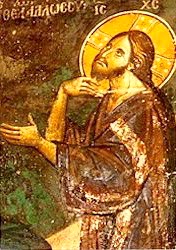 If I was given sixpence every time I heard someone quoted John 17.21 ‘…that they might be one…’ then I’d have a lot of change that I wouldn’t know what to do with. It is commonly suggested that, in this, Jesus’ ‘high priestly prayer’, we see his last desire expressed to his heavenly Father, and that desire is for his people to have visible unity. We must therefore take this seriously, and make it a priority above other issues since, after all, it was so important to Jesus that it formed his final wish.
If I was given sixpence every time I heard someone quoted John 17.21 ‘…that they might be one…’ then I’d have a lot of change that I wouldn’t know what to do with. It is commonly suggested that, in this, Jesus’ ‘high priestly prayer’, we see his last desire expressed to his heavenly Father, and that desire is for his people to have visible unity. We must therefore take this seriously, and make it a priority above other issues since, after all, it was so important to Jesus that it formed his final wish.
It is worth looking at the prayer a little more closely, and putting it in its context both in John’s gospel and amongst the gospels as a whole. The prayer form the climax of the Last Supper discourse in John—but of course John himself mentions no supper, but instead focusses on the washing of the disciples’ feet by Jesus. This reminds us that we need to read John in one hand with the synoptics, and particularly Mark, in the other; the two fill out each other and give each other context. So we read that, after this prayer of John 17, Jesus goes out to Gethsemane in John 18.1, but we need to turn to Mark 14.32 to know the name of the place and what happens there.
It is also worth noting from the outset that the longer form of Jesus’ speech in John is not, in itself, a reason to treat the synoptics as more historical, and John more of a theological construction of what Jesus said. Even the speeches in John are relatively short, and the teaching of Jesus recorded in the synoptics would take mere hours to recite, so we must treat them as (quite possibly reliable) summaries of longer and more extensive teaching.
Turning to the prayer itself, we find many of the earlier themes and ideas in John drawn together. First, we meet the notions of ‘hour’ and ‘glory’; John has from the beginning been interested in days and hours, and in Cana Jesus tells Mary that ‘my hour has not yet come’ (John 2.4) and yet, in the miracle and in anticipation of what is to follow here, ‘Jesus did the first of his signs…and revealed his glory’ (John 2.11).
Then we have the interrelated ideas of life and truth: eternal life is to know the true God, whom Jesus alone reveals. In the prologue in John 1, we have already been introduced to the light who was life for the world from the beginning of creation. And that light is constantly linked with testimony—of John, of Jesus’ disciples, and of Jesus himself. The idea of the work of the Son being aligned with the work of the Father takes us back to the idea that ‘my Father is always working’ in John 5.17 and that the work demanded of us is faith—believing in what Jesus teaches (John 6.29).
The distinction of the disciples from the world touches on John’s ambiguous theology of ‘world’—it is the object of God’s love (John 3.16) but is also opposed to God and the things of God (John 15.18), so that (paradoxically) to love the world is to hate God (1 John 2.15). This contrast between the disciples and the world reflects Jesus’ own relationship with the world (John 17.16); though the world ‘came into being through him, it did not know him’ (John 1.10) and ‘his own people [both the Jews and all humanity] did not receive him’ (John 1.11). His own ministry and kingdom do not have their origin in the world—that is the real meaning of Jesus’ statement to Pilate in John 18.36, often mistranslated as ‘of this world’ rather than ‘from this world’, as if the kingdom did not have an impact on earthly structures of power. The question of where Jesus ‘remains’ or stays or abides has been of interest from the disciples’ first encounter: ‘Rabbi, where are you staying/abiding?’ (John 1.38). We now learn that Jesus abides in the Father, and we need to abide in him, and that he will no longer abide in this world but is going to the Father. (This idea of movement from the Father’s side, down to the incarnation, and up again back to the Father is neither late, not uniquely Johannine, since we find the same movement in Phil 2.5–11 and in 2 Cor 8.9).
Now we begin to approach the heart of the prayer, where the statement about unity comes. Jesus’ key concern is for the protection of the disciples in the midst of the world in which they remain but to which they do not belong. ‘Make them holy in the truth; your word is truth.’ The language of truth goes to the heart of a key theme in John; as Andrew Lincoln and Mark Stibbe have pointed out, the whole of John can be understood as a form of trial narrative, with witnesses called to testify to the truth of Jesus’ claims and identity, and the Father even called to the witness stand (John 8.18). That is why the conflict is so sharp with the ‘leaders of the Jews’ in chapters 5 to 8, because they are the prosecuting counsel, and that is why John’s account of the crucifixion naturally includes the extended dialogue with Pilate (conveyed to us by one of the servants there) which is not included in the synoptics.
‘Your word’ here cannot refer to Jesus himself, even within the ‘logos’ Christology of John, not least because Jesus has already talked of the cleansing and sanctifying work of his words, that is, his teaching of truth, in relation to abiding in the vine (John 15.3). To be holy involves remaining in the person and work of Jesus, and remaining in his teaching which reveals the truth about us, God and the world. It is into this context that Jesus then longs for the unity of his people. The parallel with the unity between Jesus and the Father cannot be exact, not least with hindsight we have following the Nicene expressions of our understanding of the Trinity. But it is about the unity of commitment, will and understanding; just as Jesus does the will and work of the Father, and just as the Father’s testimony is completely unified with the testimony of Jesus, so his disciples are to have that one commitment to true testimony which reveals the truth of God—and which will then lead many who have not themselves been witnesses of Jesus also to believe (John 20.31). There is no sense here that the unity of the believers in and of itself, disconnected to the truth, plays any role in the conviction of the world.
Jesus finishes the prayer with an inclusio return to the theme of glory, but does so with a unique address to God as ‘righteous Father’—only the third time John uses the term ‘righteous’ (after John 5.30 and 7.24) and the only time in the New Testament that God is described in this way.
So Jesus’ prayer for unity is tightly bound with concerns for the truth, for holiness, for the distinctive testimony of his people over against the world to which they do not belong, leading to the revelation of the glory of God and by which, through faithful testimony, many in the world will come to believe that Jesus is the only true revelation of the Father who loves them and draws them to himself.
And of course we find very similar inter-relationships between these concerns elsewhere. In the oft-cited example of the Council of Acts 15, it is striking that the understanding of the new experience of seeing the Spirit poured out on the Gentiles is interpreted by means of discerning God’s purposes in Scripture, and (most notably for us) is then recognised by all of God’s people in unanimity. The accord with Scripture and the unified reception by the people both attest to the truth of the interpretation.
Perhaps this is an object lesson in the dangers of the ‘memory verse’ approach to reading Scripture, by which we isolate one phrase from its immediate and wider context, and so lose important elements which it needs in order to be understood properly.
Follow me on Twitter @psephizo
Much of my work is done on a freelance basis. If you have valued this post, would you consider donating £1.20 a month to support the production of this blog?




























Fully agree that a concern for unity shouldn’t be divorced from a concern for truth, holiness and distinctive testimony.
But is Jesus’ prayer for unity *nothing more than* a prayer that believers would share a common faithfulness to the truth?
In other words, if two churches in the same town have nothing to do with each other – do not visibly love one another – but agree perfectly about their confession of faith, then are they “one” as Jesus prays they would be?
It seems obvious that the answer to this question is “no”. It’s not enough simply to have unity about what you believe. That unity must express itself in love for one another. It must be made *visible*.
Anthony, I would agree with you, though that is not obvious from this passage.
Personally, I would the look to e.g. Acts 2…but even this example appears for Luke to confirm the reality of what God is doing amongst his people, and is not simply a ‘unity’ detached from engagement in teaching. it is striking that, along with ‘breaking bread’, they also ‘attend to the apostles teaching’
So there is real and practical relationship—but there is also sharing in apostolic teaching.
I suppose, in a sense, that it’s difficult to find any passages in the Bible specifically about visible unity, simply because visible unity seems always to be assumed. The disciples in John 17 were a visibly united group of people gathered together around Jesus. They were not multiple separate flocks that Jesus tended separately (see John 10). They were one flock. What mattered here – given their visible unity – was that their unity shouldn’t be merely superficial and institutional, but that they should be of one mind (see Php 2:2).
How we apply that to a situation in which there is neither visible unity nor a common mind is not a question this passage addresses. Should we seek a common mind before even beginning to address visible unity? Or should we seek to grow towards a common mind in the context of a visible unity? Or – as I suspect – a bit of both?
Anthony,
What’s worth remembering is that, in advance of the outpouring of the Holy Spirit, the apostles, through Christ, had first-hand experience of the restorative power of the Holy Spirit.
This power gave them some idea of what to expect, as Jesus not only wrought signs and wonders, but also rebuked Simon Peter’s aversion towards His sacrificial messiahship; challenged where the apostles’ bases for establishing exclusion and superiority were at odds with the Kingdom of God, and silenced the criticism of His detractors with wise and scripturally informed responses.
This experience would have helped them to appreciate and expect that guidance promised through the gift of the Holy Spirit would often contrast sharply with the self-generated directions of their own moral compasses.
By comparison, the modern overwrought concern for the kind of unity (read, peace at any price) which the Church of England leadership is engineering today, would have most likely led to a ‘two integrities’ accommodation of circumcision, a mediation team to resolve Paul’s dispute with Barnabas over John Mark, and an apostolic working party commissioned to study the theological implications of Gentile contact before permitting Peter to evangelise them.
Oh, and I missed the employment tribunal convened to decide whether John Mark’s authorisation to support the apostle’s mission in Asia Minor amounted to a contract of employment, such that, without adequate notice, Paul had wrongfully dismissed him.
No one is addressing the fact that God did not see fit to grant Jesus’ prayer. Is this part of our theology of intercession?
Penelope,
It depends on who you think that Jesus meant by ‘they’.
I think that we could say that John has a theology not only of unity but also a theology of disunity. Ian, you pointed out how ‘world’ is positive (an object of God’s love) but also (mostly) negative in this Gospel. This would be part of a theology of disunity. There are also the conflict with ‘the Jews’ (not meaning an ethnic group but an oppositional group to the disciples, who were also Jews) or followers of Jesus being ‘thrown out of the synagogue’ or Jesus destroying the temple and rebuilding it (His body) in three days–and much more in John fits into the ‘disunity’ in the Gospel (and John’s epistles within the church community). It seems to me that an understanding of Johannine ‘disunity’ clarifies what John means by ‘unity’ even further–and this is completely in line with what you’ve written so well here. After all, if John meant by unity merely a ‘social’ unity rather than a Christocentric unity, unity in ‘the truth,’ and the unity of those ‘obeying Christ’s commandments’, we would have stories of Jesus trying to hold shared conversations with the Pharisees and Sadducees that sought only agreement at the level of pastoral accommodation.